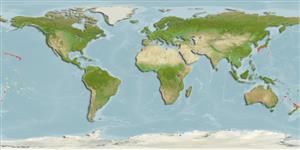Common names from other countries
Environment: milieu / climate zone / depth range / distribution range
Ecology
Marine; reef-associated; depth range 18 - 193 m (Ref. 58302). Temperate; 35°N - 50°S, 129°E - 173°W
Pacific Ocean: Pacific coast of Japan (Ref. 43239) and the Hawaiian Islands; Australia, New Zealand and Lord Howe, Norfolk and Kermadec Islands.
Size / Weight / Age
Maturity: Lm ? range ? - ? cm
Max length : 90.0 cm TL male/unsexed; (Ref. 9710)
Benthopelagic over reef and sand (Ref. 58302). Found in pairs or small groups in deep rocky drop-offs (Ref. 9710).
Life cycle and mating behavior
Maturity | Reproduction | Spawning | Eggs | Fecundity | Larvae
Hardy, G.S., 1983. A revision of the fishes of the family Pentacerotidae (Perciformes). N.Z. J. Zool. 10:177-220. (Ref. 7448)
IUCN Red List Status (Ref. 130435)
CITES (Ref. 128078)
Not Evaluated
Threat to humans
Harmless
Human uses
Fisheries: commercial; aquarium: commercial
More information
Common namesSynonymsMetabolismPredatorsEcotoxicologyReproductionMaturitySpawningFecundityEggsEgg development
ReferencesAquacultureAquaculture profileStrainsGeneticsElectrophoresesHeritabilityDiseasesProcessingMass conversion
Tools
Special reports
Download XML
Internet sources
Estimates based on models
Preferred temperature (Ref.
115969): 14.6 - 22.2, mean 18.8 (based on 42 cells).
Phylogenetic diversity index (Ref.
82804): PD
50 = 1.0001 [Uniqueness, from 0.5 = low to 2.0 = high].
Bayesian length-weight: a=0.01995 (0.00906 - 0.04395), b=3.01 (2.83 - 3.19), in cm Total Length, based on all LWR estimates for this body shape (Ref.
93245).
Trophic level (Ref.
69278): 3.5 ±0.50 se; based on food items.
Resilience (Ref.
120179): Very Low, minimum population doubling time more than 14 years (Preliminary K or Fecundity.).
Fishing Vulnerability (Ref.
59153): High vulnerability (56 of 100).
